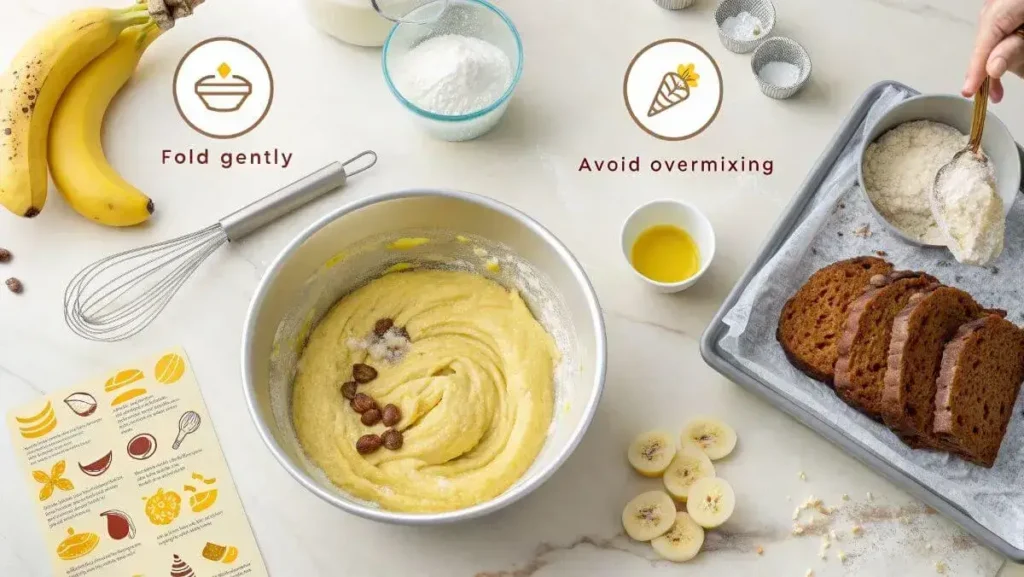Why does my banana bread not rise much? This question has puzzled many bakers, from beginners to seasoned pros. There’s nothing quite as disappointing as pulling a freshly baked banana bread, only to find it’s dense and flat instead of fluffy and risen. This familiar baking problem can arise from several factors, such as expired leavening agents or overmixing the batter. In this article, we’ll dive deeply into the science of banana bread rising, examine the most frequent mistakes, and offer practical tips to help you create that ideal fluffy loaf. Whether you’re a beginner or a seasoned baker, this guide will help you troubleshoot your banana bread recipe and turn it into a light, fluffy masterpiece.
Understanding the Basics of Banana Bread Rising
What Makes Banana Bread Rise?
Regarding baking, leavening agents like baking soda and baking powder are the unsung heroes. These ingredients produce carbon dioxide gas as they interact with moisture and heat, creating tiny air pockets that raise your banana bread. However, if these agents are expired or misused, your bread might become dense and flat.
Another key factor is the mixing process. Overmixing the batter can deflate the air bubbles while undermixing might leave pockets of dry ingredients. Achieving the right balance is essential for a perfectly risen loaf.

Common Expectations for Banana Bread Texture
Banana bread is inherently denser than cakes or muffins because of its high moisture content, but it should still have a soft, slightly springy texture. If your banana bread becomes gummy or excessively heavy, something goes wrong. Understanding the difference between dense and soft banana bread can help you identify and fix the issue.
For instance, a properly risen loaf will have a golden-brown crust and a tender crumb. If your bread is flat or heavy, it’s time to troubleshoot. We’ll cover all the bases in the following sections, whether it’s expired leavening agents, incorrect oven temperature, or too much moisture.
Key Reasons Why Your Banana Bread Doesn’t Rise
Expired or Inactive Leavening Agents
One of the most common reasons your banana bread doesn’t rise is expired or inactive leavening agents. Baking soda and baking powder gradually lose their strength over time, and if they’re not fresh, they won’t create the necessary air pockets. To test if your baking soda is still good, mix a teaspoon with vinegar—if it fizzes, it’s active. Similarly, baking powder can be tested by combining it with warm water. If there’s no reaction, it’s time to replace it.

Overmixing the Batter
Overmixing the batter is another culprit. When you mix too much, you deflate the air bubbles that help the bread rise. Instead, aim for a gentle fold until the ingredients are just combined. A few lumps in the batter are perfectly fine—they’ll disappear during baking. Remember, overmixing affects the rise and can make your banana bread tough and dense.
Incorrect Oven Temperature
Your oven temperature dramatically affects how well your banana bread rises. If the oven is too cold, the bread won’t set correctly, and if it’s too hot, the outside may cook faster than the inside, preventing it from rising evenly. Always preheat your oven and Check the temperature with an oven thermometer – even a 10°F difference can determine the success of your banana bread.
Too Much Moisture in the Batter
Bananas are naturally moist, but using overripe bananas or adding too much liquid can make the batter too wet, weighing it down and preventing it from rising. To fix this, adjust the ratio of wet to dry ingredients. For example, add more flour or reduce the amount of milk or other liquids. Alternatively, allow your mashed bananas to rest for a few minutes to drain any extra moisture, then drain it before adding it to the batter.
How to Fix Banana Bread That Doesn’t Rise
Choosing the Right Leavening Agents
Always use fresh baking soda or baking powder to ensure your banana bread rises appropriately. Please keep them in a cool, dry place and regularly check their expiration dates. If you’re uncertain about their freshness, try the simple tests we’ve discussed earlier. Also, measure them precisely—too much or too little can throw off the balance and affect the rise.
Perfecting the Mixing Process
The key to a well-risen loaf is gentle mixing. First, combine the dry ingredients in one bowl and the wet ingredients in another. Then, add the wet mixture to the dry ingredients and fold until combined. Be careful not to overmix, as this can cause the batter to lose its airiness.
Fold them in at the end if you add mix-ins like nuts or chocolate chips.
Adjusting Oven Settings
Proper oven settings are crucial for a successful bake. Always preheat your oven to the temperature specified in the recipe. If your oven runs hot or cold, adjust accordingly. Use an oven thermometer to monitor the temperature throughout baking. Also, avoid opening the oven door too often, which can cause temperature fluctuations and affect the rise.
Balancing Wet and Dry Ingredients
Banana bread batter should be thick but pourable. If it’s too wet, add a tablespoon of flour until you reach the right consistency. Conversely, if it’s too dry, add a splash of milk or another liquid. Remember, the moisture content of bananas can vary, so adjust as needed. Consider adding a dollop of yogurt or buttermilk to the batter for a lighter texture.
Advanced Tips for Fluffier Banana Bread
Incorporating Air into the Batter
One of the best ways to raise your banana bread is by incorporating air into the batter. Start by beating the eggs and sugar together until they’re light and fluffy. This creates tiny air bubbles that expand during baking, giving your bread a lighter texture. Similarly, creaming the butter and sugar together can add extra lift. If you’re using oil instead of butter, consider whipping it with the eggs for a similar effect.
Using the Right Pan
The type of pan you use can also affect how much your banana bread rises. A light-colored metal pan is ideal because it distributes heat evenly, allowing the bread to rise uniformly. Dark pans absorb more heat, which can cause the edges to bake faster than the center, leading to uneven rising. Additionally, make sure your pan is the right size—too large, and the batter will spread out too thin, too small, and it might overflow. Grease and line the pan with parchment paper to ensure easy removal and even baking.
Experimenting with Ingredients
Sometimes, a simple tweak to your recipe can make all the difference. For example, yogurt or buttermilk can create a lighter, fluffier texture due to their acidity, activating the baking soda. Similarly, mixing brown and white sugar can add moisture and help the bread rise better. If you’re feeling adventurous, try folding in whipped egg whites for an extra airy loaf.
Explore our Perfecting Your Banana Bread Recipe article for additional tasty recipes and helpful baking advice.
FAQ
How Long Does Banana Bread Last Unrefrigerated?
Banana bread stays fresh for 2-3 days when stored at room temperature.
If stored properly. For more extended storage, refrigerate or freeze it.
For more baking tips and tricks, explore our collection of Baking Essentials.
Is banana bread healthy or unhealthy?
It depends on the ingredients. Using whole wheat flour, reducing sugar, and adding nuts can make it healthier.
How do you pack banana bread for lunch?
Wrap slices in parchment paper or place them in an airtight container to keep them fresh. For more ideas, read our Banana Bread at Work tips.
What is the number one mistake made when making banana bread?
The biggest mistake many bakers make is overmixing the batter, which deflates the air bubbles needed for rising. Mix just until the ingredients are combined.
What happens if you add too much banana to banana bread?
Adding too much banana can make the batter too wet, leading to dense bread. Stick to the recipe’s recommended amount; consider using fewer if your bananas are extra large. For a foolproof guide, check out our 3 Ingredient Banana Bread recipe.
Why Does My Banana Bread Not Taste Good?
If your banana bread lacks flavor, it could be due to underripe bananas or insufficient seasoning. Ripe bananas are sweeter and more flavorful, so always use them when they’re speckled or brown. Adding a pinch of salt, cinnamon, or vanilla extract can enhance the taste.
3 Ingredient Banana Bread: Simple, Delicious, and Fast
If you’re looking for a quick and easy banana bread recipe, our 3 Ingredient Banana Bread is perfect. With just bananas, self-rising flour, and sugar, you can whip up a delicious loaf in no time. This recipe is ideal for beginners or anyone in a hurry. Also, it’s a great way to use up overripe bananas.
Troubleshooting Banana Bread Recipes
Common Mistakes to Avoid
Even minor mistakes can result in a flat loaf when baking banana bread. One standard error is overpacking flour when measuring, which can make the batter too dry and heavy, hindering its rise. Instead, use the spoon-and-level method: Spoon the flour into the measuring cup and use a knife to level it off. Another mistake is skipping the preheating step. If the oven isn’t hot enough when you put the bread in, it won’t rise properly. Always preheat your oven for a minimum of 10 minutes before baking. Additionally, avoid opening the oven door too often, which can cause temperature fluctuations and affect the rise.
How to Salvage Dense Banana Bread
If your banana bread turns out dense, don’t despair! There are ways to repurpose it into something delicious. For example, you can slice and toast it lightly in the oven to make banana bread croutons. These are perfect for topping yogurt or ice cream. Alternatively, turn it into a bread pudding by soaking slices in a custard mixture and baking until golden.
Pro Tips for Perfect Banana Bread Every Time
Choose the Right Bananas
The key to great banana bread starts with the bananas. Use overripe bananas with brown spots for maximum sweetness and moisture. If your bananas aren’t ripe enough, bake them at 300°F for 15-20 minutes to soften them. This step ensures your bread has the best flavor and texture.
Measure Ingredients Accurately
Precision is crucial in baking. Use a kitchen scale or measuring cups and spoons to ensure you’re adding the right amounts. Too much flour can dry your bread, while too little can make it dense. Always spoon and level flour instead of scooping it directly from the bag.
Don’t Skip the Preheating Step
Preheating your oven ensures even baking from the start. Your bread won’t rise properly if the stove isn’t hot enough. Use an oven thermometer to verify the temperature – even a 10°F difference can make or break your banana bread.
Test for Doneness
To check if your banana bread is done, insert a toothpick into the center. If it comes out clean or with a few crumbs, it’s ready. If not, bake for a few more minutes. Overbaking can dry out the bread, while underbaking can leave it gummy.

Conclusion – Mastering the Art of Banana Bread
Why Does My Banana Bread Not Rise Much?
If you’ve been asking yourself, “Why does my banana bread not rise much?” you’re not alone. Baking is a science, and small changes can make a big difference. Every step matters, from using fresh leavening agents to perfecting your mixing technique.
The Joy of Baking
Baking banana bread should be fun, not frustrating. Don’t be afraid to experiment with different ingredients and techniques. For example, add a pinch of cinnamon or nutmeg for extra flavor, or swap out some of the sugar for honey for a unique twist.
Practice Makes Perfect
Like any skill, baking takes practice. Don’t give up if your first few loaves don’t turn out as expected. Keep trying, and soon, you’ll be baking banana bread that rises beautifully every time.

